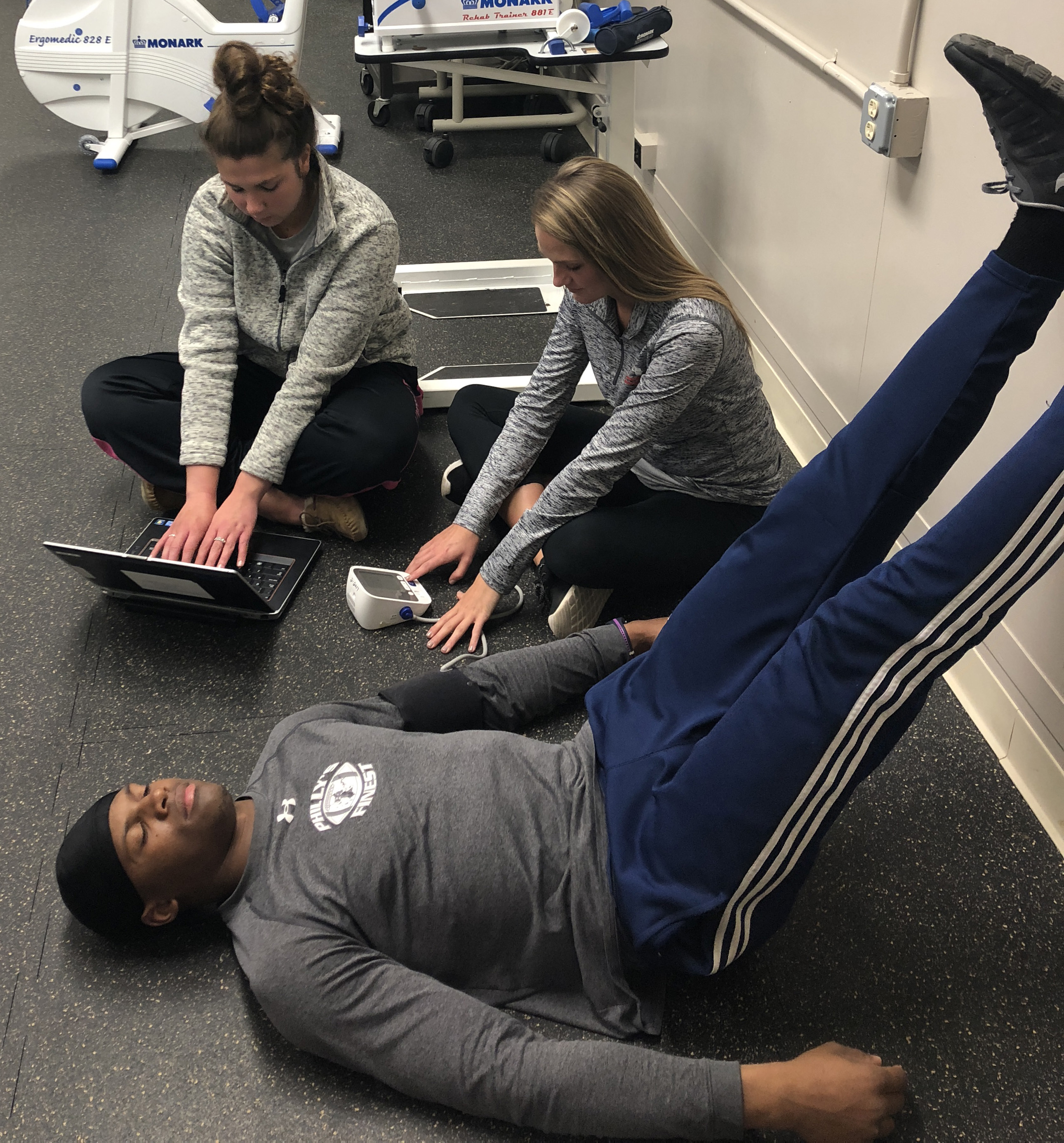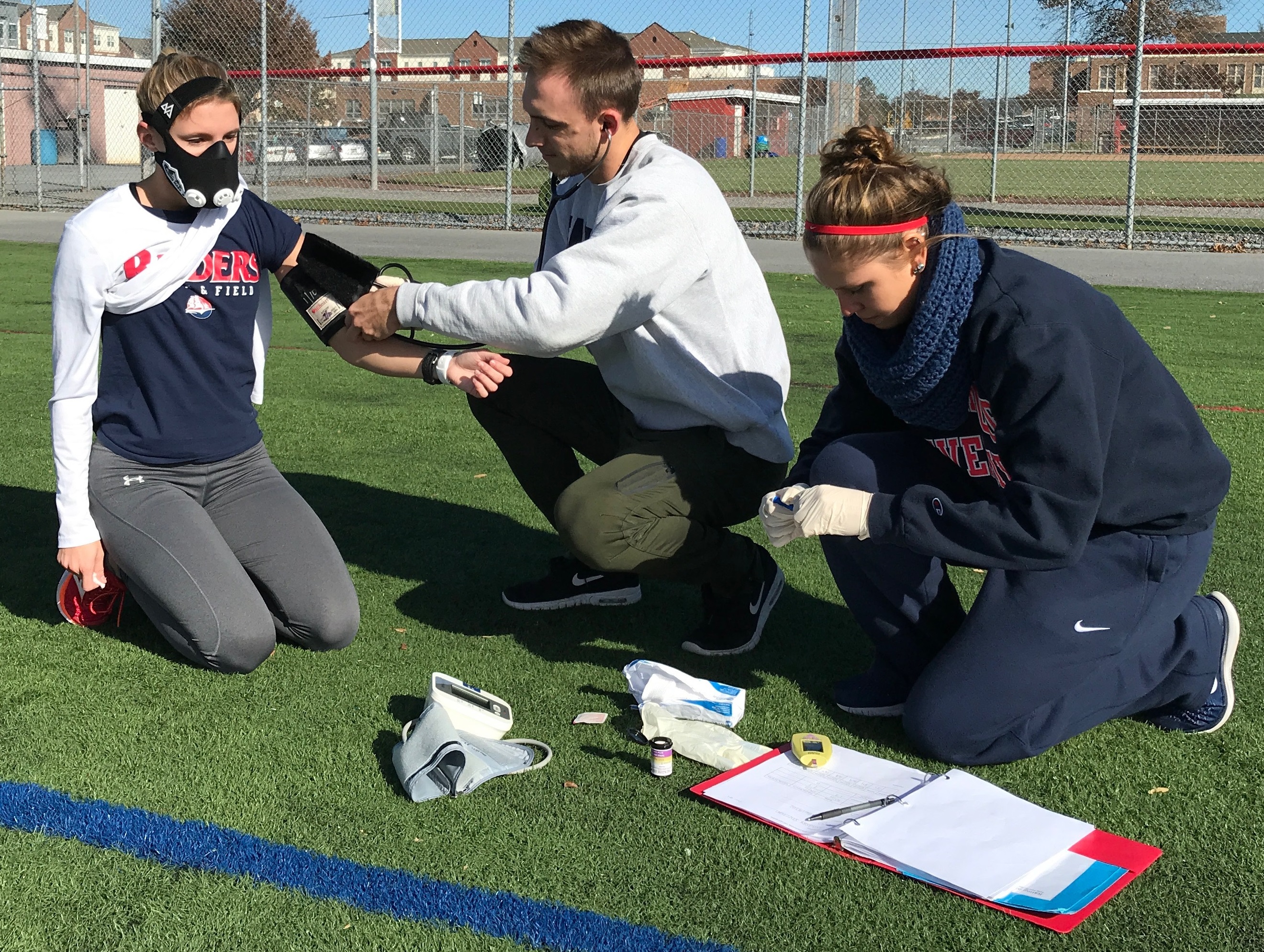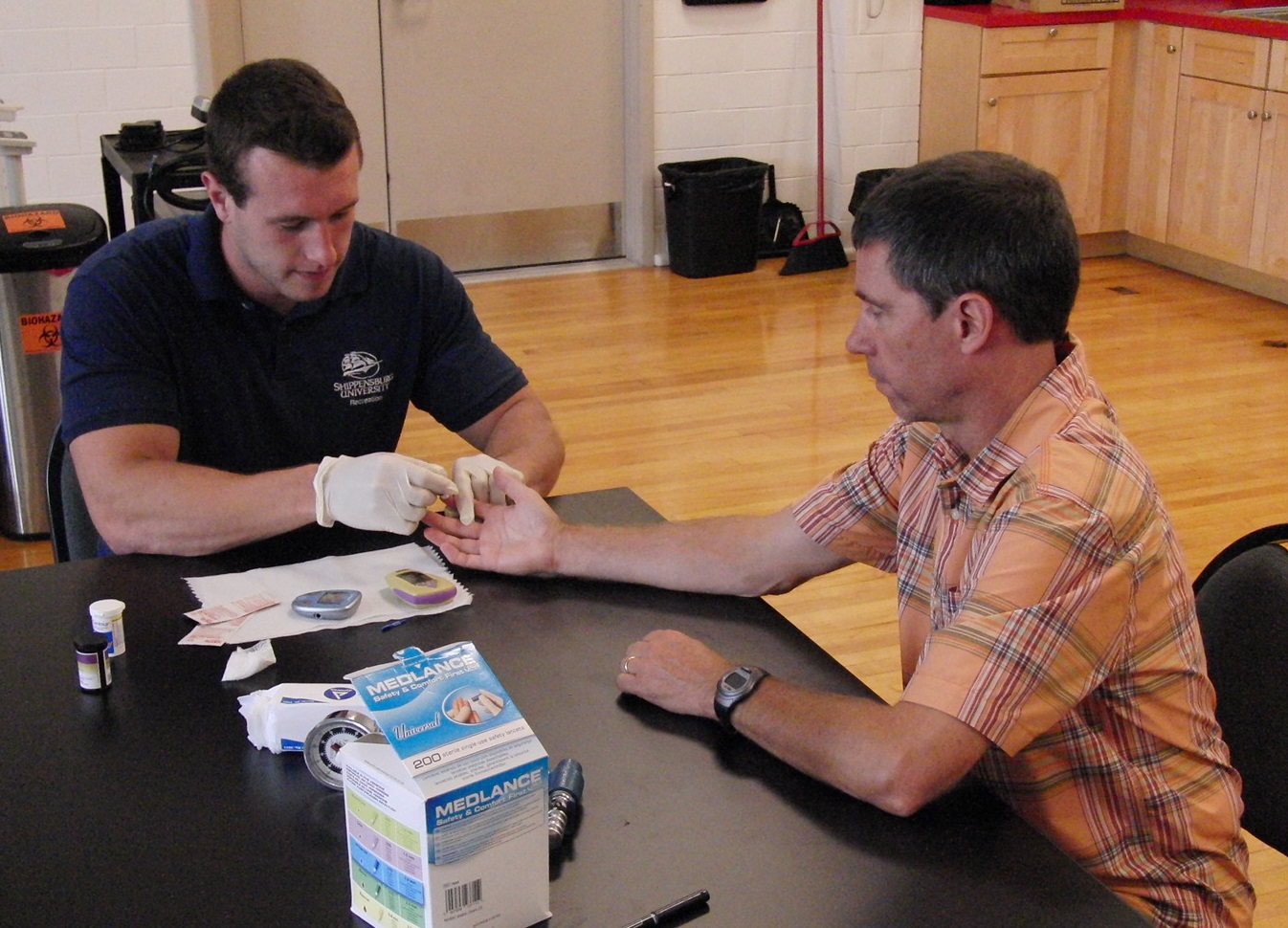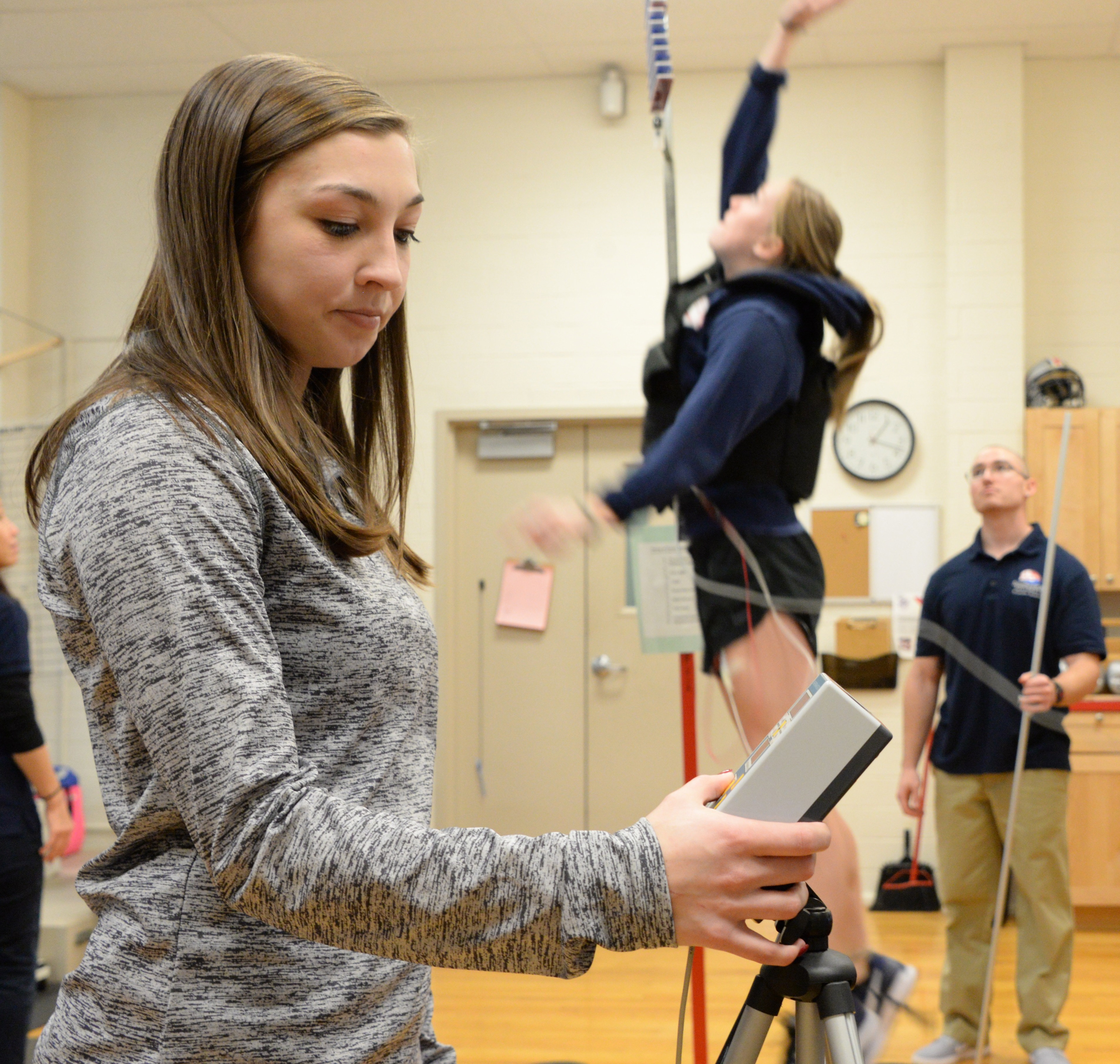Student Research
Understanding research is critical for being an effective, informed professional. As a science, research is the evidence from which we draw to make recommendations for designing exercise, rehabilitation, and health programs. Research can help physical therapists test new rehabilitation protocols, strength and conditioning coaches teach the biomechanics of a lift, and corporate fitness specialists to determine the best way to encourage physical activity in the workplace.
Our focus on student research sets the Exercise Science Department apart from other programs and universities. In class, students learn how to read and critique research studies. But our students go beyond reading studies by designing, running, and analyzing their own research projects, usually in small groups and with the supervision of faculty. Additionally, we encourage our students to attend and present their research at local and regional conferences, and since 2015 our students have given over 100 presentations at local and regional conferences such as the Mid-Atlantic Regional Chapter of the American College of Sports Medicine Conference (MARC-ACSM).
Our students receive funding for their work from sources such as the SU Undergraduate Research Grant and Summer Undergraduate Research Experience. The Keystone Journal of Undergraduate Research, which is for high-caliber student research conducted at PASSHE institutions, has also published many of our students' projects over the years, including:
- The Effects of COVID-19 on Physical Activity Levels in Shippensburg University Students (2022) by Courtney Lesik & Gavin Atkins
- The Acute Effects of Loaded Jump on Vertical Jump and Perception of Performance (2018) by Taylor Halteman, Austin Hoffman, Selma Hamzabegovic, & Caitlin Wallace
- The Effect of Training Status on Resting Glucose Tolerance in a Collegiate Population (2017) by Ali Stouffer, Tyler Ezolt, Elizabeth Stein, & Kimberly Wallace
- Comparison of Estimated Aerobic Power to Measured Aerobic Power in Aerobically Trained Athletes (2017) by Lucas Van Horn, Matthew Cuomo, Shane Huntbach, Alicia O'Donel, & Chris Mullins
In short, we are a campus and regional leader in undergraduate student research. Our students leave Ship with a thorough understanding of how to read and conduct basic research in Exercise Science and its sub-disciplines. These skills are attractive to employers and especially to graduate programs, where students will spend even more time reading and analyzing research.
Want to know what else our students have explored the past couple of years? Keep scrolling to check out our featured student-developed research projects!
Cardiovascular Recovery in Two Different Recovery Positions in Male College Students

Student Researchers: Amanda Stubits, Abby Wagner, Thomas McIntyre & Angela Tarabrella
Faculty Mentor: Dr. Joohee Sanders
This project examined the effects of two recovery positions on heart rate recovery (HRR) and systolic blood pressure recovery (BPR) after a submaximal run. Thirteen male students participated in the study. Subjects were required to complete a VO2 max test on the first day of testing. For the two following testing days, subjects completed a 10-min submaximal run on a treadmill followed by 5-min in one of the recovery positions. The two recovery positions were active recovery at 3.5 mph and supine with legs elevated. Significant differences were found between active recovery and supine with legs elevated for HRR (p < .05). However, there were no significant difference in BPR between the conditions. This research suggests that different recovery positions could enhance recovery after aerobic exercise.
Physiological Effects of an Elevation Mask on Endurance Trained Athletes vs. Non-Endurance Trained Athletes

Student Researchers: Tara Bicko, Jamie Blair, Kyle Fields, & Makenzie Magnotta
Faculty Mentors: Dr. Sam Forlenza & Dr. Turi Braun
Many athletes train with an elevation training mask, however, studies are still unclear regarding the effectiveness of these training tools. The purpose of this research was to observe physiological adaptations in college endurance trained athletes and non-endurance trained athletes while performing 100 yard sprints with and without an elevation training mask. Participants were 10 collegiate athletes who had their heart rate, blood pressure, rate of perceived exertion, and lactic acid values recorded throughout the exercise protocol to assess changes over time. The results showed significant differences between pre to post time values, but no significant interaction effects between groups.
This project was funded by a 2017 Undergraduate Research Grant for $393.00 and presented at the 2018 Minds@Work Conference.
Influence of Caffeine on Resistance Exercise Performance and Post-Exercise Glucose Control

Student Researcher: Daniel Hauck
Faculty Mentor: Dr. Turi Braun
Dan was interested in learning more about how caffeine affects resistance exercise performance and blood sugar following the completion of a weightlifting exercise. To explore this topic, he completed a research internship under the supervision of Dr. Braun and was awarded a student research grant. Dan used these funds to examine the influence of pre-exercise caffeine on resistance exercise performance. Further, he examined whether caffeine affects the body's ability to regulate blood sugar during an oral glucose tolerance test (OGTT). Based on the study outcomes, caffeine supplied prior to the OGTT (with and without resistance training exercise) tended to suppress blood sugar clearance.
This project was funded by a Summer Undergraduate Research Experience grant and presented at the Mid-Atlantic Regional Chapter of the American College of Sports Medicine Conference and at the Success Now! Exposition.
Acute Effects of Loaded Jump on Vertical Jump and Perception Performance

Student Researchers: Taylor Halteman, Austin Hoffman, Selma Hamzabegovic, & Caitlin Wallace
Faculty Mentors: Dr. Sally Paulson & Dr. Joohee Sanders
The purpose was to investigate if performance and perception of the vertical jump (VJ) were acutely impacted by applying an external load. Sixteen subjects completed three testing sessions which entailed performing three sets of five VJ. During the second set of jumps, subjects wore a weighted vest at either 5%, 10% or 15% of their body mass. Results showed VJ displacement, average power, and average velocity were significantly higher following the removal of the vest. All subjects perceived they jumped higher and felt lighter while wearing the 10% and 15% weighted vest. These findings suggest performing a vertical jump with external load can increase acute vertical jump height, average power, and velocity following the removal of the load.
This project was presented at the 2017 Mid-Atlantic Regional Chapter of the American College of Sports Medicine Conference, where it was nominated for the Matthew Kerner Undergraduate Student Investigator Award, and presented at the 2018 Minds@Work Conference.
Effects of a Six-Month Walking Intervention on Physical Activity among Older Adults
Student Researchers: Joseph Farabaugh, Tyler Cover, Morgan Horowitz, & Hector Raya
Faculty Mentors: Dr. Sally Paulson, Dr. Sam Forlenza, Dr. Ben Meyer, & Dr. Joohee Sanders
The purpose of this study was to track and evaluate a pedometer-based walking program evaluating physical activity levels in a sample of older adults living in a rural community. Sixteen subjects self-selected to participate in the walking group (WG) and 5 volunteered for the control group (CON). The WG followed a ramping protocol designed to increase steps weekly by 1,000 steps until they reached a daily goal of 10,000 steps/day. The CON was asked to continue their normal activity while wearing a pedometer. Results showed that the WG significantly increased their physical activity compared to the CON, with a higher 12-week average in the WG (7251±3305 steps/day) versus the CON (2692±799 steps/day). These results suggest that implementing a pedometer-based walking program, with goals for individuals to achieve, is an effective way of increasing physical activity in older adults.
This project was funded by a Summer Undergraduate Research Experience grant and presented at the 2015 Mid-Atlantic Regional Chapter of the American College of Sports Medicine conference and the Success Now! Exposition.

